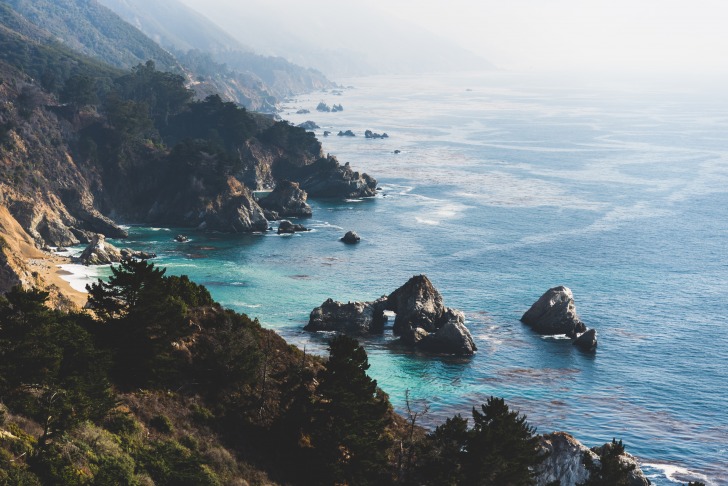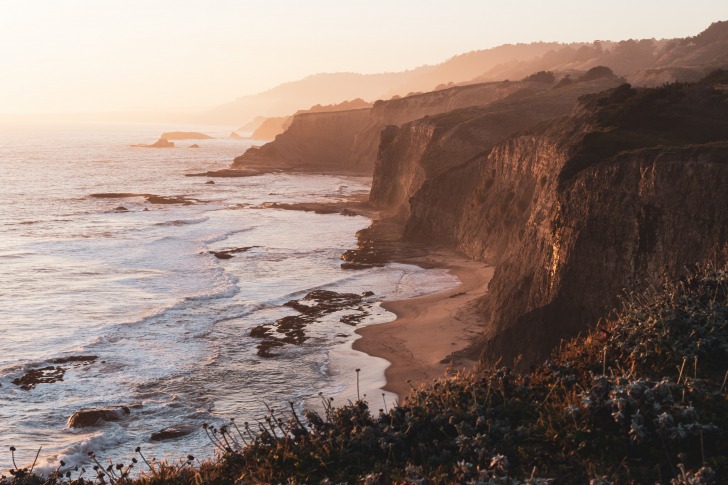California is a western US state.
The state stretches for over 900 miles along the Pacific coast from the Mexican border.
California has some of the most beautiful beaches in the United States.
And, in the water just off the coast, the Pacific Ocean is home to a wide range of wildlife.
Some of the marine mammals you’ll find on the west coast include seals, sea lions, killer whales, sea otters, humpback, and gray whales, to mention a few.

Contents
So… Are There Sharks in California
Yes, some of the most dangerous sharks known to man roam the Pacific Ocean and the western coast of the United States.
Great white sharks (Carcharodon carcharias) migrate all along the coast of the US and many other parts of the world.
And, they are known for the most attacks on humans in history.
These sharks travel to the west coast during the summer when the water is warmer and closer to their preferred temperature.
The adults don’t often come nearshore, but juvenile white sharks are often seen in southern California in shallow waters near shore.
The thresher shark (Alopias vulpinus) is also present on the west coast.
These sharks are considered to be harmless to humans.
Many of the sharks found in these waters feed off plankton, other fish, and crustaceans and are considered to be harmless to humans.
However, the Great White shark, the tiger shark, and the bull shark are three of the most dangerous sharks known to man and all three of them swim in the waters on the Pacific coast.
Solana Beach in San Diego County is known for having the most shark attacks in the state of California.
In the last century, there have been over 20 unprovoked shark attacks in the area.
The most interesting part is that, even though the waters on the west coast are completely infested with sharks, shark attacks are still considered to be uncommon due to the number of attacks versus the time period versus the number of people that swim on these beaches.
Though California is considered third in the US for the most shark attacks on humans.
The temperature of the water on the Pacific coast ranges from mild and warm in the summer to cooler in the winter.
Essentially, many sharks migrate to this coast in the summer due to the climate and warm water.
There are many different shark species that call the Pacific coast their home, but in this list, we will only look at the top seven species of sharks.
- Great white sharks (Carcharodon carcharias)
- The thresher shark (Alopias vulpinus)
- Smooth hammerhead sharks (Sphyrna Zygaena)
- The megamouth shark (Megachasma Pelagios)
- Basking sharks (Cetorhinus Maximus)
- Tiger sharks (Galeocerdo Cuvier)
- The whale shark (Rhincodon Typus)
Although the bull shark hasn’t quite made it to our top seven list, they are still present on the west coast, closer to the Mexican border where the water is warmer and closer to their desired temperature.
That means that three of the most dangerous sharks in the world are present on the west coast during the summer, which includes the Great White, the tiger shark, and the bull shark.
Many of the other species of sharks present on the west coast feed off other fish; sharks, crustaceans, or seals.
They are harmless to humans and are not known to attack.
For example, the whale shark, which is a species of shark that grows to be nearly 23 feet in size, is known as the gentle giant of the ocean.
They are bigger than Great White sharks but are harmless to humans and there has not been a record of a whale shark attack on any human in history.
The San Diego Tribune reported in 2008 the most fatal shark attack just 150 yards offshore in Tide Park.
The victim was a 66-year-old swimmer.
It’s always advised to exercise caution when venturing into waters known to host sharks.
Especially in California, where there is a multitude of visitors and tourists that frequent the beaches in the summer.
Is it Safe to Swim in California?
Many people flock to California to swim, surf, paddle, kayak, and jet ski in the ocean, lakes, rivers, and dams.
But, whether it is safe to do so is another question.
Firstly, the water quality in California is a question of concern.
There are advisory boards at many of the water bodies in and around California, warning swimmers of possible bacteria in the water and levels above the required levels for safety.
Many of the beaches do comply with safe bacteria levels though.
The second concern is the sharks in the water.
Apart from having several different species of sharks, one of the deadliest sharks can be found on the west coast, the Great White shark.
The waves in the ocean on the west coast include crushing shore breaks and powerful surf.
These water conditions can be very dangerous.
Especially considering the piers, sheep cliffs, unguarded beaches, and strong currents, which make swimming in the ocean in California a little bit dangerous.
Swimmers should always exercise extreme caution when swimming on the west coast.
Especially during the summer when shark activity is known to be at its highest.
If there is a shark attack on the west coast, it’s most likely to occur in central California.
Interesting Shark Facts in California
This fact may not be specific to California, but it is specific to sharks.
There are over 500 different species of sharks.
They are considered to be apex predators and vary enormously in size.
Sharks play a very important part in the ecosystem of the ocean and are an indicator of the health of the ocean.
They have very few, if any, predators that hunt them.
A very interesting fact about the female shark is that some female sharks are able to reproduce independently.
This type of reproduction is known as asexual reproduction.
This means that their unfertilized eggs are able to grow into fully formed sharks.
There are, however, some drawbacks to this type of reproduction.
There is less genetic diversity, which means that these sharks are more prone to diseases.
There are only three different shark species that are responsible for the most attacks on humans and the most fatal attacks on humans.
They are the Great White shark, the bull shark, and the tiger shark.
In addition, the United States sees the most shark attacks on humans than any other country in the world.
Although many of these attacks are not fatal.

Most sharks live in salt water.
There are exceptions, like the bull shark, which has adapted to fresh water but predominantly lives in salt water.
There are freshwater sharks that only live in freshwater and do not venture into salt water.
Saltwater makes sharks more buoyant.
Research suggests that most sharks are less buoyant in freshwater.
Most bony fish have gas-filled swim bladders that help them stay afloat in salt water.
However, sharks have oil-filled livers that help them stay afloat.
These livers are very large and in order to stay afloat in fresh water, the sharks would require an especially large liver.
Some sharks, such as the Ganges sharks, have exceptionally large oil-filled livers that are adapted to living in freshwater environments.
That is why these types of sharks are able to live and thrive in freshwater and rarely, if ever, venture into salt water.
Sharks have salt in their bodies.
They are often saltier than the saltwater they live in.
They take the saltwater in through their gills and they filter out what they do not need.
The salt content in freshwater is too low for saltwater sharks.
They have not adapted to these waters.
The lack of salt will cause their cells to rupture, their bodies to bloat, and they will eventually die.
River sharks or freshwater sharks, have lower salt content in their bodies and do not experience the same problems as freshwater sharks.
3 Safety Tips for Swiming in Shark-infested Waters
- Don’t swim in shark-infested water. The first and most obvious safety tip is to avoid swimming in water where sharks are known to be present. Especially sharks that have a reputation for being aggressive towards humans, such as Great Whites and bull sharks. You can take some precautionary steps to ensure that you don’t deliberately find yourself swimming in shark-invested water, such as knowing when feeding times are for sharks, knowing what type of water sharks typically swim in, and knowing the area where you will be swimming.
- Avoid wearing bright colors or shiny jewelry when going to swim in the ocean. Sharks use their eyesight to detect their prey and they are attracted to shiny things and bright colors. The shiny objects may mimic the scales of a fish for sharks, which may entice the shark to attack.
- Stay out of the water if you are actively bleeding. Sharks have a very keen sense of smell. They can smell blood in the water from hundreds of yards away.
Summary
The water temperature isn’t ideal year-round in California to attract sharks.
Sharks are very specific about their preference for water temperature.
One of the species of shark most prevalent in these waters is the Great White shark.
One of the most dangerous apex predators of the ocean.
You’ll find their young closer to the shore and you’ll find these sharks mostly during the summer months when the water is warmer.
Shark attacks are fairly common on this coast, as California ranks third in the United States for the most shark attacks.
While many people travel to the state to enjoy the beaches, swimmers are advised to be very cautious when in the water.
California Safety Overview
READ THE FULL REPORT: California Safety Review
Safety Index:
- OVERALL RISK: MEDIUM
- TRANSPORT & TAXIS RISK: MEDIUM
- PICKPOCKETS RISK: MEDIUM
- NATURAL DISASTERS RISK: HIGH
- MUGGING RISK: MEDIUM
- TERRORISM RISK: MEDIUM
- SCAMS RISK: HIGH
- WOMEN TRAVELERS RISK: MEDIUM
Frequently Asked Questions
Are shark attacks common in California?
No.
In fact, California is the third state in the United States with the most shark attacks.
There have been recorded 307 shark attacks on the west coast.
Nearly all of these attacks have been unprovoked.
Of the total number of shark attacks in California, 24 of these attacks were fatal.
The very first recorded shark attack happened in the year 1851.
The most recent shark attack occurred in June 2022.
What time of year are sharks most active in California?
Sharks are most active in California during the summer.
From April through October, sharks participate in what is known as the hunting season.
This time period constitutes summer to fall.
During this period, Great White sharks can be seen coming closer to the shoreline in search of food.
Where are shark attacks most common in California?
The area in California known for the greatest Great White shark attacks is known as the “Red Triangle”.
This area stretches from Bodega Bay all the way through to the Farallon Islands, and then down to Point Sur.











